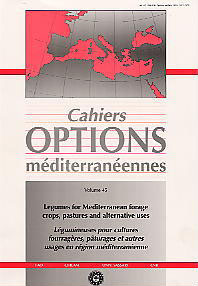| Article précédent | p. 331-342 | Article suivant |
Persistence and regeneration mechanisms in forage legumes
Persistence, an important attribute of forage legumes, is influenced by climate, management, pests, and by their interrelations in a given environment. The main mechanisms of germination control, in the reproductive regeneration of annual legumes, are the seed bank dynamics, hardseededness and its breakdown pattern. Seed burial ability, seed dispersal and pod and seed characteristics and their relationship with animal ingestion and excretion are also very important. Persistence of perennial legumes is typically based on the vegetative regeneration even though seed regeneration can be also involved. Persistence strategies and ecological adaptation of perennials are related to one of the following growth characteristics: 1) presence of a deep taproot system and woody crown assuring persistence due to the survival of the original plants; 2) production of rooted stolons which can persist after the original plant has died and 3) plant spread and persistence by the formation of rhizomes.
- [ Télécharger ]
- [ Exporter la citation ]
Vous pouvez télécharger la citation au format :
- [ Imprimer ]
- [OMC45]




